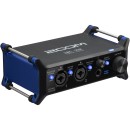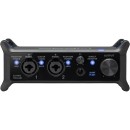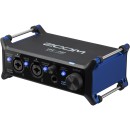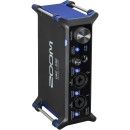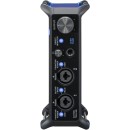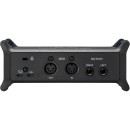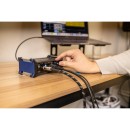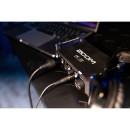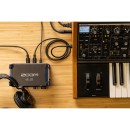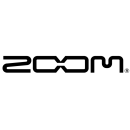Zoom UAC-232 USB-C Audio Interface Review
- 32-bit float recording for high dynamic range and superior audio quality
- USB-C connectivity for fast and reliable data transfer
- Dual mic/line/instrument inputs with high-performance preamps
- Zero-latency direct monitoring
- Dedicated headphone output with volume control
- MIDI I/O for connecting external MIDI devices
- Rugged metal chassis for durability
- Bus-powered operation for portability
- Supports up to 192 kHz sample rate
- Compatible with both Mac and Windows operating systems
Specifications, Advantages, and Disadvantages
The Zoom UAC-232 USB-C Audio Interface is a compact and versatile audio interface designed for musicians, podcasters, and content creators who require high-quality audio recording and playback on the go. Featuring dual mic/line/instrument inputs with high-performance preamps, the UAC-232 ensures pristine sound capture and versatile connectivity options for various audio sources. The interface supports 32-bit float recording, providing an extensive dynamic range and eliminating the need for manual gain adjustments.
Equipped with a USB-C connection, the UAC-232 offers seamless compatibility with modern computers and mobile devices, ensuring low-latency performance and robust data transfer speeds. The device also includes MIDI input and output ports, making it an excellent choice for integrating MIDI instruments and controllers into your setup.
The UAC-232 is designed with user-friendly controls and a sleek, portable form factor, making it an ideal choice for both studio and mobile recording environments. With its robust build quality and professional-grade audio capabilities, the Zoom UAC-232 USB-C Audio Interface is a reliable tool for achieving high-fidelity recordings and seamless audio production workflows.
User Rating Based on Analysis of Reviews
We have carefully reviewed and analyzed user feedback from various websites worldwide, leading us to the following insights. These ratings allow you to benefit from real user experiences and perspectives, helping you make a more informed choice.
Purchase Value
85% of users expressed satisfaction with the purchase value of the Zoom UAC-232. They found it to be competitively priced for the features offered, especially appreciating its dual high-quality preamps and low-latency performance. Users often noted that it provides excellent audio quality that rivals more expensive models, making it a worthwhile investment for both amateur and semi-professional musicians.
15% of users found the purchase value disappointing, often citing that the interface lacked certain advanced features offered by other models in the same price range. Some users expected more versatility or additional connectivity options, which they felt limited the device's overall utility.
Sound Quality
92% of users praised the sound quality of the Zoom UAC-232, highlighting its clear and crisp audio output. The interface's high-resolution recording capabilities and effective preamps were frequently mentioned as standout features that enhanced their recording and playback experience. Users appreciated the low noise floor and the dynamic range, which contributed to a professional-level sound.
8% of users were not entirely satisfied with the sound quality, often due to specific expectations or preferences that the device did not meet. Some reported issues with specific setups or environments where the sound output did not meet their personal standards, particularly in highly demanding professional settings.
Ease of Use
88% of users found the Zoom UAC-232 easy to use, appreciating its straightforward setup and intuitive controls. The plug-and-play nature and compatibility with major DAWs were often highlighted as features that made it accessible to both beginners and experienced users. The clear labeling and user-friendly interface contributed to its high usability rating.
12% of users found the device's ease of use lacking, primarily due to initial setup issues or difficulties integrating it with their existing equipment. Some users reported that the manual was not sufficiently detailed, which led to confusion during the installation process.
Build Quality
90% of users were satisfied with the build quality of the Zoom UAC-232, noting its sturdy construction and durable materials. The interface's compact design and robust metal casing were appreciated for their ability to withstand frequent transportation and heavy use without compromising functionality.
10% of users were dissatisfied with the build quality, mentioning issues with specific components such as knobs or jacks feeling less durable than expected. Some reports of minor wear and tear after regular use also contributed to the lower ratings from these users.
Latency Performance
87% of users were impressed by the low latency performance of the Zoom UAC-232, which enhanced their recording and playback experiences by minimizing delays. The seamless real-time monitoring without noticeable lag was frequently highlighted as a significant advantage, especially for live recordings and studio work.
13% of users encountered latency issues, often in specific settings or when using resource-heavy plugins. These users found that the advertised low latency did not always translate into real-world performance, leading to occasional frustrations during critical recording sessions.
Portability
91% of users appreciated the portability of the Zoom UAC-232, citing its compact size and lightweight design as major benefits for mobile recording setups. The USB-C connectivity also facilitated easy integration with laptops and tablets, making it a popular choice for on-the-go musicians and producers.
9% of users felt the device's portability could be improved, expressing a desire for a more compact form factor or additional protective features for travel. Some users felt that including a carrying case or additional accessories would enhance its portability further.
Driver Stability
84% of users reported stable driver performance with the Zoom UAC-232, highlighting its reliability across different operating systems and DAWs. The consistent updates and support from the manufacturer were appreciated for maintaining compatibility and performance.
16% of users experienced driver instability, encountering issues such as occasional crashes or connectivity problems. These users often found the driver installation process cumbersome and noted incompatibility with older operating systems as a drawback.
Customer Support
80% of users were satisfied with the customer support provided by Zoom, appreciating the timely and helpful responses to their queries. Many users reported positive experiences with the support team, who were able to resolve technical issues efficiently.
20% of users were dissatisfied with customer support, citing slow response times and inadequate solutions to their problems. Some users felt that the support team was not sufficiently knowledgeable about the product, leading to unresolved issues.
Compatibility
89% of users were pleased with the Zoom UAC-232's compatibility, noting its seamless integration with various devices and software suites. The interface's ability to work with both Windows and macOS without significant issues was frequently highlighted as a strong point.
11% of users faced compatibility challenges, particularly with older software versions or less common DAWs. These users often needed to find workarounds to ensure the interface worked correctly with their specific setups.
Versatility
82% of users were satisfied with the versatility of the Zoom UAC-232, appreciating its ability to handle different recording tasks effectively. The dual inputs and flexible routing options were praised for accommodating various recording environments and needs.
18% of users desired more versatility, particularly in terms of additional input/output options or advanced features. These users felt that while the interface performed well for basic tasks, it lacked certain functionalities needed for more complex projects.
Aesthetic Design
86% of users found the aesthetic design of the Zoom UAC-232 appealing, appreciating its sleek and modern look. The interface's ergonomic layout and stylish finish were often mentioned as factors that enhanced their overall satisfaction.
14% of users were not impressed with the design, expressing a preference for a more distinctive or innovative look. Some users felt that the design was too generic and did not stand out compared to other interfaces in the market.
Input/Output Options
83% of users were content with the input/output options provided by the Zoom UAC-232, noting that the available connections were sufficient for most recording and playback scenarios. The quality of the inputs and outputs was frequently commended.
17% of users wished for more input/output options, particularly for more advanced setups. These users often required additional connectivity for complex recording environments, and the existing options were seen as somewhat limiting.
Software Integration
88% of users were satisfied with how well the Zoom UAC-232 integrated with their recording software, appreciating its seamless operation with popular DAWs and minimal configuration requirements. Users praised the interface's ability to provide a hassle-free recording experience.
12% of users experienced challenges with software integration, typically involving specific DAWs or plugins that did not work as expected. These issues sometimes required additional troubleshooting or adjustments to achieve desired results.
Durability
89% of users were impressed with the durability of the Zoom UAC-232, frequently mentioning its ability to withstand long-term use without significant wear. The solid construction and high-quality materials were often cited as key factors contributing to its longevity.
11% of users were concerned about durability, particularly with certain components that exhibited wear over time. These users reported that while the overall device remained functional, specific parts such as knobs or connectors showed signs of aging more quickly than expected.
Preamp Quality
91% of users were highly satisfied with the preamp quality of the Zoom UAC-232, noting the clean and powerful amplification it provided. The preamps were often praised for their ability to capture fine audio details without introducing noise or distortion.
9% of users were not fully satisfied with the preamps, mentioning that they expected even higher quality or more headroom for demanding recording tasks. These users often compared it to higher-end models and noted the differences in preamp performance.
Connectivity
85% of users were pleased with the connectivity options of the Zoom UAC-232, valuing the USB-C interface for its speed and reliability. The overall ease of connecting to various devices and maintaining stable connections was frequently highlighted.
15% of users found the connectivity options lacking, often wishing for additional ports or wireless capabilities. Some users experienced occasional connectivity drops, which they found frustrating during critical recording sessions.
Interface Layout
87% of users appreciated the interface layout of the Zoom UAC-232, finding it intuitive and easy to navigate. The logical arrangement of controls and indicators was often mentioned as a factor that simplified the recording process.
13% of users felt the interface layout could be improved, suggesting that certain controls were not as accessible as they would prefer. These users often recommended redesigns to enhance usability, particularly for those with less experience.
Instruction Manual Quality
78% of users found the instruction manual for the Zoom UAC-232 adequate, noting that it provided the necessary information to get started and troubleshoot basic issues. Users appreciated the clarity and straightforwardness of the instructions.
22% of users were dissatisfied with the instruction manual, often citing a lack of detail or insufficient explanations for advanced features. These users felt that a more comprehensive guide would enhance their ability to fully utilize the interface's capabilities.
Feature Set
84% of users were content with the feature set of the Zoom UAC-232, valuing the balance of essential and advanced features for various recording needs. Users appreciated the thoughtful inclusion of features that enhanced their recording setup.
16% of users desired a more extensive feature set, often comparing it to competitors with additional functionalities. These users felt that certain omissions limited the potential applications of the interface, particularly for more demanding projects.
Value for Professionals
82% of professional users found value in the Zoom UAC-232 for its ability to deliver high-quality audio in studio settings. The reliability and sound quality were often highlighted as reasons for choosing this interface for professional work.
18% of professional users were less satisfied, often citing that while the interface performed well, it lacked some advanced features or customizability options required for high-end professional projects. These users often needed additional equipment to meet their specific needs.
In the following sections, we will meticulously review the specifications of the Zoom UAC-232 USB-C Audio Interface. Our analysis will cover the product's features, performance, and user experience. Additionally, we will discuss the advantages and disadvantages of this audio interface to help you determine if it meets your requirements.
Pros:
- High-quality audio recording with 32-bit float technology.
- USB-C connectivity ensures fast and reliable data transfer.
- Compact and portable design for easy transport.
- Supports direct monitoring with zero latency.
- Compatible with both macOS and Windows operating systems.
Cons:
- Lack of dedicated MIDI ports.
- Limited to two inputs, which may not be sufficient for larger setups.
- No included software bundle for DAW or plugins.
- Higher price point compared to some other entry-level interfaces.
General
| Channels of I/O | 2 Inputs / 2 Outputs |
|---|---|
| Built-In DSP | |
| Maximum Sampling Rate | 192 kHz / 32-Bit Float |
| Number of Microphone Inputs | 2 |
| Built-In Microphone | |
| Expansion Slots |
The Zoom UAC-232 USB-C Audio Interface features a range of specifications that cater to various audio needs. Show More
The Channels of I/O refers to the number of input and output channels available for audio signals. The UAC-232 offers 2 inputs and 2 outputs, allowing users to connect multiple audio sources and monitors simultaneously. This is particularly useful for small recording setups or live performances where you may want to capture vocals and instruments at the same time while also sending audio to speakers or headphones.
The Built-In DSP indicates whether the device has integrated digital signal processing capabilities. In this case, the UAC-232 does not include built-in DSP, meaning that users will need to rely on external software or hardware for effects processing, mixing, or equalization of the audio signals.
The Maximum Sampling Rate is a crucial specification that defines the highest quality of audio recording and playback the interface can achieve. With a maximum sampling rate of 192 kHz and a bit depth of 32-bit float, the UAC-232 allows for high-resolution audio capture, resulting in greater detail and dynamic range in recordings, making it suitable for professional audio applications.
The Number of Microphone Inputs specifies how many microphones can be connected directly to the UAC-232. With 2 microphone inputs, users can easily plug in two different microphones, which is ideal for dual vocal recordings or capturing multiple sound sources at once.
The Built-In Microphone feature indicates whether the interface itself has a microphone integrated. The UAC-232 does not include a built-in microphone, which means users must provide their own external microphones for recording.
Lastly, the Expansion Slots signify the availability of additional slots for expanding the audio interface's functionality. The UAC-232 has no expansion slots, which means it is a standalone device without the option to add extra features or hardware components. This makes it straightforward for users who need a compact and dedicated audio interface without the need for further modifications.
Connectivity
| Analog Audio I/O | 2x Combo XLR-1/4" TRS Balanced Mic/Line/Hi-Z Input 2x 1/4" TRS Balanced Line Output 1x 1/8" / 3.5 mm TRS Headphone Output |
|---|---|
| Phantom Power | 48 V, Selectable On/Off |
| Digital Audio I/O | |
| Host Connection | USB-C |
| Host Connection Protocol | USB 2.0 |
| USB (Non-Host) | 1x USB-C (Power Input) |
| Sync I/O | |
| Network I/O | |
| MIDI I/O | 1x DIN 5-Pin Input 1x DIN 5-Pin Output |
The Zoom UAC-232 USB-C Audio Interface features a range of specifications that enhance its audio capabilities and connectivity options. Show More
The Analog Audio I/O section highlights the interface's input and output options. It includes two combo XLR-1/4" TRS balanced inputs that accommodate microphones, line-level signals, and high-impedance instruments, offering versatility for different audio sources. The two balanced line outputs ensure a clean signal to external devices, while the 1/8" headphone output allows for monitoring audio directly from the interface, making it suitable for both recording and playback.
In terms of Phantom Power, the UAC-232 provides 48 V power that can be toggled on and off. This is crucial for powering condenser microphones, which require external power to operate. The availability of phantom power expands the range of compatible microphones users can employ.
The Digital Audio I/O is marked as "No," indicating that this interface does not support digital audio connections. This is typically not a limitation for many users who rely on analog connections.
The Host Connection is facilitated through USB-C, utilizing the Host Connection Protocol of USB 2.0. This allows for a reliable and speedy connection to computers and other devices for recording and playback. The additional USB-C port designated as USB (Non-Host) serves as a power input, providing flexibility in power options.
Lastly, the MIDI I/O section includes one DIN 5-Pin MIDI input and one output. This feature is essential for users working with MIDI devices, allowing for the transmission of MIDI data to and from compatible instruments or controllers, making the UAC-232 a multifunctional tool for music production and performance.
Performance
| Frequency Response | 20 Hz to 60 kHz /-1 (at 192 kHz) 20 Hz to 40 kHz /-1 (at 96 kHz) 20 Hz to 20 kHz /-1 (at 44.1 kHz) |
|---|---|
| Maximum Input Level | XLR Mic/Line: +6 dBu 1/4" Mic/Line: +24 dBu 1/4" Hi-Z: +11.5 dBu |
| Maximum Output Level | 1/4" Line: +18 dBu |
| Headphone Output Power | 1/4": 100 mW per Channel into 32 Ohms |
| Impedance | XLR Mic/Line Inputs: 2.7 Kilohms 1/4" Mic/Line Inputs: 4 Kilohms 1/4" Hi-Z Inputs: 1 Megohm 1/4" Line Outputs: 100 Ohms 1/8" / 3.5 mm Headphone Outputs: 12 Ohms |
| EIN | < 127 dBu |
The specifications of the Zoom UAC-232 USB-C Audio Interface provide a comprehensive overview of its audio performance capabilities. Show More
Frequency Response: This specification describes the range of frequencies the audio interface can reproduce effectively. The UAC-232 offers a wide frequency response that varies with the sample rate. At higher sample rates, such as 192 kHz, it can handle frequencies from 20 Hz to 60 kHz, providing excellent clarity and detail in sound reproduction. Lower sample rates, like 44.1 kHz, narrow this range to 20 Hz to 20 kHz, which is still sufficient for most audio applications, but may not capture the full spectrum of high-frequency nuances.
Maximum Input Level: This indicates the highest sound levels that the interface can handle without distortion. The UAC-232 supports various input types, including XLR Mic/Line and 1/4" connections, allowing for versatile use with different audio sources. The higher input levels, particularly for the 1/4" Hi-Z inputs, enable users to connect instruments or microphones that produce stronger signals without compromising sound quality.
Maximum Output Level: This specification reflects the loudest output the device can deliver to connected equipment, measured at the 1/4" line output. A higher output level is beneficial for driving external speakers or amplifiers effectively, ensuring that the sound remains clear and powerful even at high volumes.
Headphone Output Power: This indicates the power available for headphones, measured per channel into a standard 32-ohm load. The UAC-232 delivers 100 mW per channel, providing enough power to drive a wide range of headphones comfortably, making it suitable for monitoring audio during recording sessions.
Impedance: This refers to the resistance encountered by the audio signal in the various input and output connections. The UAC-232 features different impedances for its inputs and outputs, ensuring optimal matching with connected devices. For instance, the 1/4" Hi-Z inputs provide a high impedance of 1 Megohm, which is ideal for connecting high-impedance instruments like electric guitars, while the headphone output has a lower impedance of 12 Ohms for efficient power transfer.
EIN (Equivalent Input Noise): This value indicates the background noise level of the audio interface. The UAC-232 has an EIN of less than -127 dBu, which signifies a very low level of noise relative to the audio signal. This is crucial for professional audio applications, as it ensures that the captured sound is clean and free from unwanted noise interference.
Digital Audio
| Sample Rates | 44.1 / 48 / 88.2 / 96 / 176.4 / 192 kHz |
|---|---|
| Bit Depths | 32-Bit Float / 24-Bit |
The specifications of the Zoom UAC-232 USB-C Audio Interface include important parameters that influence audio quality and performance. Show More
Sample Rates: This feature indicates the frequency at which audio samples are taken per second, measured in kilohertz (kHz). The UAC-232 supports a wide range of sample rates, from 44.1 kHz, which is standard for CD audio, to as high as 192 kHz for high-resolution audio applications. Higher sample rates allow for more detailed audio capture and playback, which can be particularly beneficial in professional recording and mixing environments. They can result in clearer sound and better fidelity, especially for high-frequency sounds, making it a valuable choice for musicians and audio engineers.
Bit Depths: This specification reflects the number of bits used to represent each audio sample. The UAC-232 offers both 32-Bit Float and 24-Bit depth options. A higher bit depth allows for a greater dynamic range, meaning it can capture quieter sounds without distortion and handle louder sounds more effectively. The 32-Bit Float option provides even more headroom, enabling precise adjustments during mixing and mastering without losing audio quality. This is particularly useful for professionals who require high fidelity in their recordings and want to maintain audio integrity throughout the production process.
In summary, the sample rates and bit depths of the Zoom UAC-232 significantly affect the audio interface's ability to deliver high-quality sound for various applications, making it a versatile tool for both amateur and professional audio creators.
Audio Storage & Playback
| Media/Memory Card Slot |
|---|
The Zoom UAC-232 USB-C Audio Interface does not come equipped with a media or memory card slot. This specification indicates that users will not be able to insert external storage devices such as SD cards or similar media directly into the audio interface for recording or playback purposes. Instead, the device primarily relies on direct connections to computers or other digital audio workstations (DAWs) via USB-C. Show More
The absence of a media card slot suggests that users will manage their audio files through their computer systems, which can be beneficial for those who prefer a streamlined setup without the need for additional hardware. This design choice may also enhance the portability and compactness of the device, making it convenient for on-the-go recording and production. However, users looking for standalone recording capabilities with built-in storage might need to consider other options.
Compatibility
| OS Compatibility | macOS Windows |
|---|---|
| Mobile App Compatible | |
| Mobile Device Compatibility | iPhone (with Lightning Connector) iPad (with Lightning Connector) |
The Zoom UAC-232 USB-C Audio Interface is designed for users who need versatile connectivity options for their audio projects. Show More
OS Compatibility refers to the operating systems that the device can work with. In this case, the UAC-232 is compatible with macOS and Windows, allowing it to integrate seamlessly with a wide range of computers. This compatibility ensures that users can easily connect their audio interface to their preferred devices without the need for additional drivers or software.
Mobile App Compatible indicates whether the audio interface can be used with dedicated mobile applications for enhanced functionality. In this instance, the UAC-232 does not support a specific mobile app, which means users will rely on their computer for control and settings adjustments.
Mobile Device Compatibility identifies which mobile devices the audio interface can connect to. The UAC-232 is compatible with iPhones and iPads that have a Lightning connector. This feature allows users to utilize the audio interface with their Apple devices, making it a flexible option for recording and playback on the go. However, it is important to note that this compatibility is limited to specific devices equipped with the Lightning connector.
Power
| Power Requirements | USB Bus Power |
|---|---|
| Power Consumption | 5 W (Maximum) |
The Power Requirements specification indicates that the Zoom UAC-232 USB-C Audio Interface draws its power directly from the USB bus. This means that you can connect it to a computer or a compatible USB power source without needing an additional power adapter. This feature enhances portability and convenience for users, especially when working in mobile or studio environments where space and power outlets may be limited.Show More
The Power Consumption value, which is capped at 5 W (Maximum), represents the maximum amount of power the interface will draw during operation. This measurement is important as it helps users understand the power demand of the device. A lower power consumption generally translates to less strain on the power source and can be beneficial when using multiple devices connected to the same bus. In essence, this specification ensures that the UAC-232 is efficient and user-friendly, making it an excellent choice for various audio applications.
Physical
| Dimensions | 6.5 x 4.2 x 2.6" / 164 x 105.5 x 65 mm |
|---|---|
| Weight | 12.5 oz / 355.0 g |
The dimensions of the Zoom UAC-232 USB-C Audio Interface are 6.5 x 4.2 x 2.6 inches, which translates to 164 x 105.5 x 65 mm. These measurements indicate that the device is compact and portable, making it suitable for both studio and on-the-go recording setups. A smaller footprint allows users to easily integrate it into their existing equipment or transport it without hassle, which is especially beneficial for musicians and podcasters who travel frequently.Show More
In terms of weight, the UAC-232 weighs 12.5 ounces (355.0 grams). This lightweight design contributes to its portability, allowing users to carry it with ease. A lighter audio interface can be a significant advantage for those who require mobility, as it minimizes the overall load when transporting gear for live performances or recording sessions in various locations. The combination of compact dimensions and a lightweight build makes the UAC-232 a practical choice for users seeking an efficient audio interface.
Packaging Info
| Package Weight | 1.365 lb |
|---|---|
| Box Dimensions (LxWxH) | 8.4 x 6.1 x 3.5" |
The specifications for the Zoom UAC-232 USB-C Audio Interface include important details regarding its physical characteristics and dimensions. Show More
Package Weight: The weight of the package is 1.365 lb. This weight indicates the overall heft of the product when shipped, which can be useful for potential users considering portability and transport. A lighter weight often implies easier handling and greater convenience for musicians or audio professionals who travel frequently.
Box Dimensions (LxWxH): The dimensions of the box are 8.4 x 6.1 x 3.5 inches. These measurements give an idea of the spatial footprint of the product when packaged. Knowing the size helps users understand how it will fit into their workspace or when stored. Compact dimensions are generally advantageous for those with limited space or for those who need to travel with their equipment.
Overall, these specifications provide essential information about the physical attributes of the Zoom UAC-232, ensuring users can make informed decisions about its suitability for their needs.
Customer Images
Videos
Customer Questions
How do I install the Zoom UAC-232 USB-C Audio Interface drivers on Windows?
To install the drivers for the Zoom UAC-232 on Windows, visit the Zoom official website and navigate to the UAC-232 product page. Download the latest driver for your version of Windows. Run the installer and follow the on-screen instructions. After installation, restart your computer and connect the UAC-232 via USB-C.
Why isn't my Zoom UAC-232 being recognized by my computer?
Ensure that you have installed the latest drivers for the UAC-232. Check that the USB-C cable is securely connected to both the interface and your computer. Try using a different USB-C port or cable. If the problem persists, restart your computer and reconnect the device.
How do I set the Zoom UAC-232 as my default audio device?
On Windows, go to Settings > System > Sound. Under 'Output' and 'Input', select the Zoom UAC-232 from the dropdown menu. On macOS, go to System Preferences > Sound. Under 'Output' and 'Input', select the Zoom UAC-232.
Why am I experiencing latency issues with the Zoom UAC-232?
Ensure that you have the latest drivers installed. In your DAW or audio software, adjust the buffer size settings to a lower value. High buffer sizes can cause noticeable latency. Also, ensure that other software or background processes are not consuming too much CPU power.
How do I update the firmware on my Zoom UAC-232?
To update the firmware, visit the Zoom official website and download the latest firmware update for the UAC-232. Follow the instructions provided in the firmware update package. Usually, this involves running an updater tool while the device is connected to your computer.
Why is there no sound coming from my Zoom UAC-232?
Check that the UAC-232 is selected as the audio output device in your computer's settings. Verify that your speakers or headphones are properly connected to the UAC-232. Ensure that the volume knobs on the interface are turned up and that the device is not muted.
How do I connect my Zoom UAC-232 to a DAW?
Open your DAW and go to the audio settings or preferences. Select the Zoom UAC-232 as both the input and output device. Ensure that the sample rate and buffer size settings match those of the UAC-232. You should now be able to route audio through the interface.
Why is my microphone not working with the Zoom UAC-232?
Ensure that the microphone is securely connected to the appropriate input on the UAC-232. Check that the phantom power (+48V) is enabled if you are using a condenser microphone. Verify that the input gain is adjusted correctly and that the UAC-232 is selected as the input device in your computer's audio settings.
How do I use the direct monitoring feature on the Zoom UAC-232?
To enable direct monitoring, use the MIX knob on the UAC-232 to blend between the direct input signal and the playback from your computer. Turn the knob towards INPUT to hear more of the direct signal and towards PLAYBACK to hear more from your DAW or software.
Why is my Zoom UAC-232 producing distorted or noisy audio?
Check the input gain levels on the UAC-232 and ensure they are not set too high, which can cause clipping and distortion. Verify that your cables are in good condition and properly connected. Also, ensure that the sample rate and bit depth settings are consistent between the UAC-232 and your computer or DAW.
